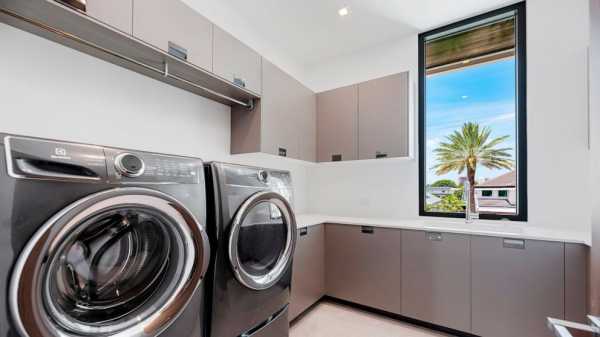
Doing laundry is a relatively boring task. But it doesn’t have to be done in a drab, boring room.
With a few strategic changes, even a small laundry room can become a space that’s appealing to be in and can double as a room for other activities too.
“Laundry rooms don’t need to be a space that we apologize for anymore,” says New York-based interior designer Deborah Martin.
Here, Martin and two other designers — HGTV’s Brian Patrick Flynn and Miami-based Raquel Mothe, of Mothe Design — offer advice on turning a basic laundry room into a space you love.
LOCATION, LOCATION
Especially in older homes, one of the least convenient things about the laundry room is where it is — often far from where laundry gets generated.
If you’re remodeling, Flynn says, consider relocating your laundry room as close to the master bedroom as possible. In fact, make it part of your master bedroom closet, if there’s enough space.
“This makes it way easier for homeowners to tackle their laundry without having to then bring it back and forth across the house,” he says.
And though it’s a splurge, it’s worth considering having more than one space where laundry gets done.
When working on new luxury home projects, Mothe says, she often includes one laundry room on the house’s main level for cleaning things like small rugs, pet toys, pool towels and other household items. She puts another laundry space with similar design and the same machines on the second floor near the bedrooms.
GO BRIGHT AND BOLD
Have fun with color and pattern, the designers say.
Mothe rarely uses white for a laundry room, aiming for a cozier vibe.
If there are colors you love but think are too bright for other rooms, Flynn suggests using them in your laundry room. It’s also a great place for patterns that seem too much for a living room or bedroom. Wallpaper’s a good way to do that.
“Nine times out of 10,” Flynn says, “I find that simply adding wallpaper to a laundry room or laundry closet instantly makes it feel more inviting.”
If you’re updating the floor, Martin suggests creating a cheerful space with an interesting tile design.
HELPFUL DETAILS
Martin and Mothe both advise including a really large sink in a laundry room. And Martin suggests adding a drain in the floor.
“We never plan for accidents, but accidents happen,” she says.
Martin also recommends built-in bins or baskets for separating clothes.
Also: Have plenty of space for drying items that you won’t be putting in the dryer. “Let’s say you are washing a silk blouse that you are not sending to the dry cleaners,” Mothe says. Install a bar with hangers or a retractable hanging rack.
Mothe also adds drying racks for clients who will be washing things like sneakers and other shoes.
BEST LIGHTING
Laundry rooms need plenty of light, and that can include what designers call “statement lighting” — something gorgeous that brightens the room and adds a dose of style.
Flynn suggests adding a pendant light or even some kind of chandelier, if space allows.
Recessed ceiling lighting is also helpful, Martin says, especially over areas where you’ll be trying to get out a stain or sorting clothes.
And if you’re doing new construction or remodeling, Martin says, give your laundry room plenty of windows. Even if we’re just doing laundry, she says, “We can enjoy a little light. We can enjoy a view.”
STRATEGIC STORAGE
Don’t forget to add a few tall cabinets for things like brooms or ironing boards, Mothe says. And she thinks it’s worth investing in high-quality countertops.
A detail like that, she says, can “make a difference between the regular laundry and the luxury one.”
If your laundry room also includes open shelving, Martin suggests storing items in apothecary jars or large Mason jars. “They’re a nice option to store stray things like collar stays, misplaced buttons or even detergent pods,” she says. “There’s no reason we can’t put our detergent in something pretty.”
But do add plenty of closed storage, since much of what you may be storing probably isn’t especially attractive, Flynn says.
“Concealed storage is super important, especially counter-to-ceiling when possible. There are so many essential supplies involved with laundry and not many are aesthetically pleasing,” Flynn says. “Keeping everything behind cabinet doors is key.”
CONSIDER OTHER USES
Martin has one client who uses her laundry room to cut and arrange fresh flowers. So the room was designed with extra storage space related to that hobby.
If you’re building or remodeling, consider expanding your laundry area’s size and purpose, perhaps combining your mudroom and laundry room.
This is especially good “for active families with kids and pets,” Flynn says.
“I’ve found that the more space allotted to a laundry room,” he says, “the less of a task space it becomes and the more of a social space it begins to feel like.”
EDITOR’S NOTE – Melissa Rayworth writes lifestyles stories for The Associated Press. Follow her on Twitter at https://twitter.com/mrayworth
Sourse: abcnews.go.com






